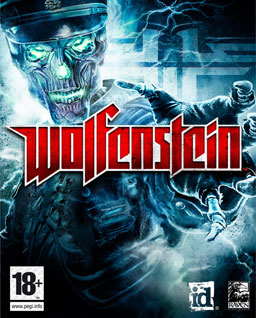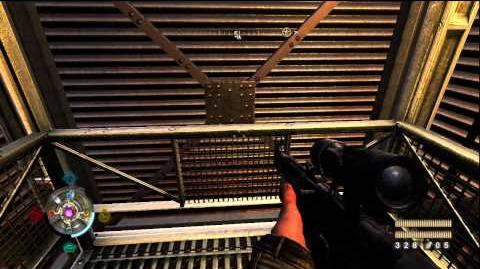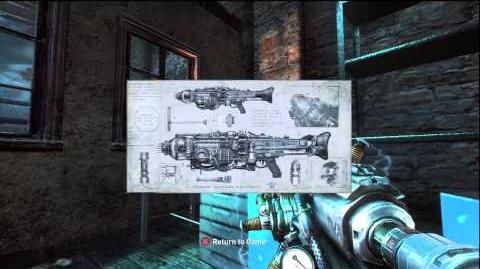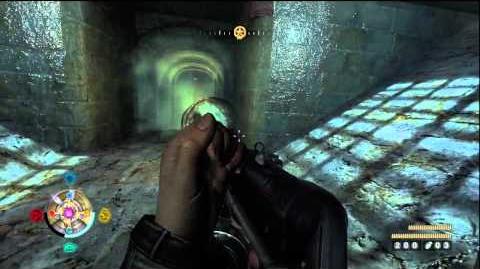(Adding categories) Tag: categoryselect |
(Adding categories) Tag: categoryselect |
||
| Line 108: | Line 108: | ||
[[Category:Wolfenstein series]] |
[[Category:Wolfenstein series]] |
||
[[Category:Wolfenstein locations]] |
[[Category:Wolfenstein locations]] |
||
| + | [[Category:Locations]] |
||
Revision as of 13:20, 8 May 2015

The European box art of the game.
- This article is about the 2009 video game. For other uses of "Wolfenstein", see Wolfenstein (disambiguation).
Wolfenstein is the 2009 direct sequel to Return to Castle Wolfenstein. The game has been described as the long awaited game and sequel, due to the fact it was in development for eight long years.
Overview
Wolfenstein is the previous game in the Wolfenstein series, co-developed by Raven Software, Id Software, Pi Studios, and Endrant Studios and published by Activision. It was released for the Xbox 360, Playstation 3 and PC in August 2009 and became available on the Steam distribution network in October 2009. The game runs on a heavily modified Id Tech 4 (aka Doom 3) engine, with physics simulation using the Havok engine.
The game featured a "re-imagined" dark-haired BJ Blazkowicz, retaining the unshaven look seen in Return to Castle Wolfenstein and dressed in civilian clothes rather than his usual military uniform. He is usually depicted carrying an MP 40, though in the introduction he is shown with the M1911 pistol he used in several missions in the previous game.
Wolfenstein is followed by Wolfenstein: The New Order, which was released in May 2014 and a prequel DLC Wolfenstein: The Old Blood which takes place between.
Setting
The story is set in the fictional town of Isenstadt, which the Nazis have taken complete control of in order to mine rare Nachtsonne crystals necessary to access the Black Sun Dimension. As the game progresses, happenings in Isenstadt become stranger (Military patrols are replaced by supernatural creatures, etc.) Locations include the town's sewers, a tavern, a hospital, a farm, an underground mining facility, a church, the SS headquarters, a dig site and caverns, a cannery, a radio station, a paranormal base, a general's home, a castle, an airfield and a large Zeppelin.
The Befolgen Sie! (You follow/obey) propaganda posters seen in the game mark an event in Hamburg occurred on Sept 3, 1944. Many are covered by layers of old newspapers suggesting that posters have been up for a fairly long time. This would suggest that the game takes place later than the date given in the poster, supporting the possibility of the game taking place later in late 1944 or 1945 (potentially supporting the connected visual graphic novels, although the GN do not give any specific dates either). The reference to Manhattan Project breakthrough and successes may also offer a view into the placement of the game. Other background documents in the game also appear to be dated to 1945.
Plot
The Nazis discover a new source of power in the form of the Veil, a mysterious dimension which can be manipulated using crystals found in the contested city of Isenstadt. The Allies discover their plan after BJ Blazkowicz infiltrates the battleship Tirpitz to prevent a missile launch on London. He recovers a Thule Medallion from a Nazi General, returning it to the OSA in London who order him to go to Isenstadt and discover what the Nazis have planned.
In an introduction sequence, special agent B.J. Blazkowitz steals a medallion from a general on a German battleship. Discovered and captured, he unleashes the power of the medallion, which kills all his foes for him. Hijacking a plane, he escapes and returns to the OSA headquarters. During a meeting there, he learns that the medallion needs crystals called Nachtsonne, mined only in Isenstadt, to make use of its full power. The Nazis have begun digging for crystals, led by a general named Victor Zetta. Blazkowicz is sent to Isenstadt, but his cover is blown by an unknown informant. He then meets up with agents from the Kreisau Circle, a resistance group dedicated to freeing Isenstadt from the Nazis, and with them, makes it to Isenstadt. In Isenstadt, he meets the brothers Stephan and Anton Kriege, who run the Black Market where Blazkowicz can upgrade all of his weapons and powers. (He pays for upgrades with gold earned from missions or found scattered throughout the game.) He also meets the leader of the Kreisau Circle, a former schoolteacher named Caroline Becker. Becker sends Blazkowicz on a mission into a dig site, where he frees a young Russian named Sergei Kovlov. He also finds an exact copy of the medallion that he found on the Nazi warship, which Kovlov calls the Thule Medallion. Kovlov introduces Blazkowicz to the Golden Dawn, a group of scholars who specialize in the occult, led by Dr. Leonid Alexandrov.
The youth also shows Blazkowicz how to use the Thule Medallion. With a crystal provided by Kovlov, Blazkowicz is able to enter the Veil, a barrier between the real world and a dimension known as the Black Sun. Using the Veil, he manages to escape. As Blazkowicz completes more missions, he gains new weapons and new defensive and offensive powers for the Thule Medallion. Eventually, he manages to kill General Zetta, who turns out to be a monster when viewed through the Veil. The Black Market, the Kreisau Circle, and the Golden Dawn then move to a new location in downtown Isenstadt to escape retaliation for Zetta's death.
Shortly after the move, Caroline Becker is captured and held in a nearby castle. Blazkowicz helps the Kreisau Circle stage a rescue mission. He confronts Zetta's replacement, Wilhelm “Deathshead” Strausse, who is eager for revenge after the events of Return to Castle Wolfenstein. During a struggle, Caroline is killed by Hans Grosse, Deathshead's henchman. Upon Blazkowicz's return to Isenstadt, Stephan Kriege informs him that he has killed his brother for being a mole and betraying both Blazkowicz and Caroline. Blazkowicz then finds out that a Nazi superweapon, powered by Black Sun energy, is about to be fired at the city from a zeppelin. He boards the airship, where he discovers that Dr. Alexandrov is also a traitor. Alexandrov's treachery is rewarded only by an execution at the hand of Hans Grosse.
In order to prepare the weapon, Deathshead and Grosse enter the Black Sun through a portal that Nazi scientists had excavated and reassembled. Blazkowicz jumps in after them. In the Black Sun, he encounters Hans Grosse guarding the machine that powers Deathshead's superweapon. Grosse greets him in a mechanical suit outfitted with two chainguns (recreating his earlier appearance in Wolfenstein 3D), and a Thule Medallion identical to Blazkowicz's. Blazkowicz kills Grosse by jamming the Nachtsonne crystals from his medallion into Grosse's. He then destroys the machine, but Deathshead flees through the portal before B.J. can capture him. The explosion takes out both the portal and the Zeppelin on the other side, effectively destroying all ways of accessing the Black Sun . In a post-credits cutscene, Deathshead is seen clambering out of the zeppelin wreckage, screaming in frustration. Ultimately, Blazkowicz and his allies successfully sabotaged the enemy's entire plan by never allowing them to use the device again for their pursuit of global domination. However, that does not stop them given the events of the next game.
Game mechanics
Wolfenstein is the first game in the series designed primarily for a console market, and the console versions feature a hybrid of the two-weapon system popularised by Halo and the unlimited inventories of older games such as Return to Castle Wolfenstein. The eight usable weapons are selected using a radial wheel, while tapping the weapon select button switches between the last two weapons chosen from this wheel. The PC version does not use this system; the mousewheel cycles between all weapons and individual ones can be quick-selected using the number keys. The player is also able to carry a set number of grenades, thrown using a hotkey, and can pick up and throw objects with some being usable as Melee weapons. As with many modern shooters, BJ now has regenerating health rather than requiring health packs; this means that BJ can no longer eat food or look for liquor as in previous games.
A key gameplay point is the power of the Thule Medallion which BJ acquires in the second storyline mission. The device, powered by a reserve of "Veil Energy" indicated by a bar in the bottom-left of the HUD, can be triggered at any time to grant the player access to four Veil Powers; the ability to enter the Veil, the time-slowing Mire, a protective Shield and the damage-multiplying Empower.
The game features a pseudo-open world system based around the city of Isenstadt, which is divided into two main maps (Midtown and Downtown) each with two areas seperated by loading gates. These areas act as hubs with two mission givers, the Kreisau Circle and Golden Dawn, having bases in each main map, though the Golden Dawn has no actual missions in Downtown. Missions are triggered by approaching specific gates within the hub worlds, which then lead to more traditional linear mission maps. The game features nine main missions, one boss level, and five optional side missions.
As with Return to Castle Wolfenstein, BJ can find readable papers and clipboards, now referred to as Intel and stored in a "Journal" which acts as a database and map, as well as Gold. Tomes of Power can also be found. Gold now serves a purpose rather than simply being a useless reward for finding a secret; Gold along with the money given as a reward for finishing each mission is used as currency in the Black Market which allows the player to upgrade their weapons and abilities and purchase ammunition. Since there is only a limited amount of currency in the whole game, the latter function is of dubious usefulness. Collecting a certain number of Intels or Tomes will unlock some of the upgrades, while the rest are unlocked by completing the storyline missions. While the game openly states that there is not enough money in the game for the player to purchase all the upgrades, collecting all Intels gives the player all weapon upgrades for free, while collecting all Tomes does the same for Veil Powers.
Characters
| Allies | BJ Blazkowicz · The Director · Jack Straw |
|---|---|
| Kreisau Circle | Anton Kriege · Caroline Becker · Erik Engle · Stefan Kriege · Agents |
| Golden Dawn | Leonid Alexandrov · Sergei Kovlov |
| Nazis | Hans Grosse · Richter · Viktor Zetta · Wilhelm Strasse · Wolfgang Statz · Max Greiner · Kroner |
Weapons
| Handheld weapons | Kar 98 · MP 40 · MP 43 · Particle cannon · Panzerschreck · Flammenwerfer · Tesla gun · Leichenfaust 44 · Mdl. 24 grenade · Melee weapons |
|---|---|
| Mounted weapons | MG42 · Flakvierling 38 · Keiler |
| Other | Dynamite · Melee weapons |
Enemies
| Humans | Drache Trooper · Elite Guard · Heavy Trooper · Rocket Trooper · Scribe · Soldier (Wehrmacht · Sniper · SS) · Wolfgang Statz · Veil Assassin |
|---|---|
| Creatures | Despoiled · Geist · Sniffer |
| Machines | Keiler · MG42 · Portable shield · Tiger tank |
| Bosses | Altered · Viktor Zetta · Queen Geist · Hans Grosse |
Marketing
A series of trailers dubbed "visual graphic novels" re-telling truncated versions of the plots of previous games were released prior to Wolfenstein, apparently in an attempt to tie the four main games into a single consistent timeline, with the order being Spear of Destiny, Wolfenstein 3D, Return to Castle Wolfenstein and Wolfenstein. These trailers are of dubious canonicity since the most recent game: The New Order, does not make any reference to the events of its alleged predecessors (other than the Nightmare easter egg).
Wolfenstein (2009) does make reference to Spear of Destiny (item) when the Black Market looks into B.J.'s mission records (they wonder how much it would be worth) and there is also a reference to B.J. reported to be tall and blonde in the Nazi's records, a reference to his appearance in the early games (and suggesting he has changed his hair colour), Strasse mentions in the game that Hans not to fail him again (this maybe a nod to B.J.'s previous encounter with him, and his failure in Wolfenstein 3D, as seen in the Graphic Novel (though it could also refer to his failure to defeat B.J. earlier in the game at Isenstadt castle)). However, the trailers directly contradict elements of both games (largely in the compression of events, and the way bosses are defeated).
These trailers proclaim the existence of a group called the "Fourth Reich;" this is the only time in the series that this term appears, with the actual games always calling Nazi Germany the "Third Reich.", or "The Reich". Except the framing story the fourth episode Unveiled Power introduces how B.J. infiltrated the Tirpitz, and obtained the captain's uniform, and medallion and leaves off where the game's intro begins. So it is required for a full understanding of the intro.
It is possible that very little of Wolfenstein (2009) was utilized as part of plot of Wolfenstein: The New Order. "...we asked him if the last Activision Wolfenstein game had any baring on their version to which he replied, "No it does not. We try not to include that game as part of our story. Personally, I think that Activision did a crap job." [1] In fact the designers claimed to be more of a fan of the original game in the series instead (Wolfenstein 3D).
Reception and sales
Wolfenstein met with average reviews with Metacritic rankings in the low to mid 70's for the three versions. The game did not meet sales predictions, selling a combined total of 106,000 copies in its first month, and this combined with the poor performance of X-Men Origins: Wolverine resulted in Activision laying off numerous staff at Raven Software.
Trivia
- Despite often being labelled "Wolfenstein (2009)" on the wiki, the 2009 game is the only one in the series to be simply titled just "Wolfenstein".
- Despite some pistols being seen in cutscenes (with the exception of B.J.'s in the intro cutscene) , the pistols are never used and there are no pistols ever used by the player.
- Die Wölfe are the Nazis in the German version.
Walkthrough
References to older games
- Wolfenstein features a tip at the loading screen for each part of the game. However, very rarely instead of a tip, it will simply say "GET PSYCHED". This is a reference to the "Get Psyched!" loading screen in Wolfenstein 3D and derivative works. This message appears quite alot before you fight Hans Grosse.
- After the Church mission (where you first encounter the Despoiled) one of the members of the Black Market that says random things when you talk will sometimes say "I wonder what the Spear of Destiny will fetch for a price these days," a reference to the capture of the Spear of Destiny in the game by the same name (and its mission packs).
- The Kreisau Circle, the German resistance fighters who appear briefly in Return to Castle Wolfenstein, play a much larger role in Wolfenstein.
- In the first cutscene for the Tavern Mission, the one where you first see Hans Grosse, before he gets into a fist fight with a man (a very brief one, since Hans knocks out the man in one punch) he says "Guten Tag." That is obviously a reference to how when you find Hans Grosse in Wolfenstein 3D his alert sound is "Guten Tag!"
- Some Schutzstaffel officers scream "Mein Leben!" (which means "My Life!") upon dying a direct reference to the SS Soldier from Wolfenstein 3D.
- The first intel in Dig Site is written by a "Dr. Bohren." This is presumably Dr. Carl Bohren, the writer of "A Spiritual History of the Third Reich" referenced in the readable Operation: Resurrection Project Book in Return to Castle Wolfenstein.
- One of the later Intels in the game level is General Zetta threatening a "Dr. Blavatsky," presumably some relative of Marianna Blavatsky.
- Wolfgang Statz appears to be the same officer who spoke to Himmler in Return to Castle Wolfenstein's ending.
- The Tomes are a reference to Raven's older games Heretic and Hexen.







